
The fieldfare is a member of the thrush family Turdidae. It breeds in woodland and scrub in northern Europe and across the Palearctic. It is strongly migratory, with many northern birds moving south during the winter. It is a very rare breeder in Great Britain & Ireland, but winters in large numbers in the United Kingdom, Southern Europe, North Africa and the Middle East. It is omnivorous, eating a wide range of molluscs, insects and earthworms in the summer, and berries, grain and seeds in the winter.
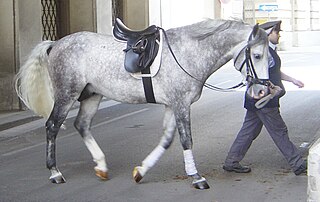
A gray horse has a coat color characterized by progressive depigmentation of the colored hairs of the coat. Most gray horses have black skin and dark eyes; unlike some equine dilution genes and some other genes that lead to depigmentation, gray does not affect skin or eye color. Gray horses may be born any base color, depending on other color genes present. White hairs begin to appear at or shortly after birth and become progressively more prevalent as the horse ages as white hairs become intermingled with hairs of other colors. Graying can occur at different rates—very quickly on one horse and very slowly on another. As adults, most gray horses eventually become completely white, though some retain intermixed light and dark hairs.
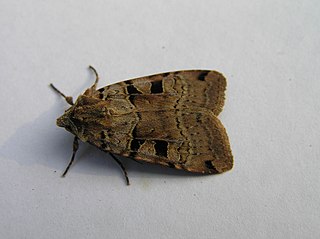
The double square-spot is a moth of the family Noctuidae. It is distributed through most of Europe except Portugal, the Mediterranean islands and northernmost Fennoscandia. In the East, the species ranges East across the Palearctic to Siberia and in the South-East to the Black Sea and in Iran. It rises to a height of about 2000 metres in the Alps.
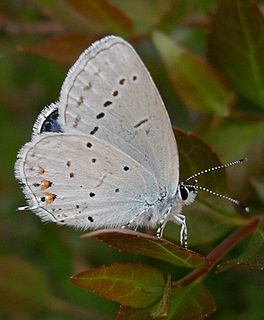
The short-tailed blue or tailed Cupid is a butterfly that forms part of the family Lycaenidae. It is found from Europe to Japan and in India.

The nutmeg, also known as the clover cutworm, is a moth of the family Noctuidae.

The Sussex is a British breed of dual-purpose chicken, reared both for its meat and for its eggs. Eight colours are recognised for both standard-sized and bantam fowl. A breed association, the Sussex Breed Club, was organised in 1903.

The grey chi is a moth of the family Noctuidae. The species was first described by Carl Linnaeus in his 1758 10th edition of Systema Naturae. It is distributed throughout Europe, although it is not present in southern Spain and Greece, as well as northern Fennoscandia. It is also found across the Palearctic including Central Asia, to the Russian Far East but not in Japan.
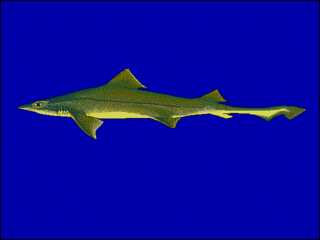
The speckled smooth-hound is a houndshark of the family Triakidae. It is found on the continental shelf of the eastern Pacific, between latitudes 0° and 54° S, at depths between 16 and 50 m. It can reach a length of 130 cm (51 in). Collectively with certain other species of shark, it is known as "tollo".

The spot-winged wood quail is a species of bird in the family Odontophoridae. It is found in Brazil, Argentina and Paraguay, and formerly in Uruguay. Its natural habitats are subtropical or tropical dry lowland forests. Its population is thought to be declining but at a moderate rate, so the International Union for Conservation of Nature has assessed it as being a "least-concern species".

The starred wood quail is a species of bird in the family Odontophoridae. It is found in subtropical or tropical moist lowland forests of Bolivia, Brazil, Ecuador, and Peru.

The soft-plumaged petrel is a species of seabird in the family Procellariidae.
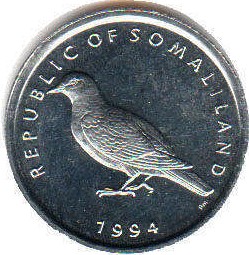
The Somali pigeon or Somali stock dove is a species of bird in the family Columbidae. It is endemic to Somalia. Because there has hardly been any research on the species, the health of the population is uncertain; however, it is believed that the species is relatively rare. The IUCN Redlist identified a possible threat to the species from the speckled pigeon. C. oliviae is found mostly on the ground, where it often forages, most frequently in rock along arid coasts.

The speckled warbler is a species of bird in the family Acanthizidae. It is endemic to eastern Australia. Its natural habitat is temperate forests.

The blue pitta is a species of bird in the family Pittidae found in the northeastern Indian subcontinent, southern China, and Indochina. It typically lives in moist forests but can also inhabit dry forest. It is an unobtrusive, solitary bird which feeds by foraging on the ground for insects and other small invertebrates.
Colonanthes is a genus of moths in the family Gelechiidae. It contains the species Colonanthes plectanopa, which is found in Brazil (Amazonas) and Peru.

Morophaga choragella is a moth of the family Tineidae. It is found in Europe.
Eulamprotes nigromaculella is a moth of the family Gelechiidae. It is found in Spain, France, Italy, Greece, Corsica, Sardinia, Sicily, Crete, Cyprus and Ukraine.
Rhopalosetia is a monotypic moth genus in the family Copromorphidae. Its only species, Rhopalosetia phlyctaenopa, is found in French Guiana. Both the genus and species were first described by Edward Meyrick in 1926.

Hakea pendens is a flowering plant in the family Proteaceae and endemic to a small area in the Goldfields-Esperance regions of Western Australia. It is a small shrub with needle-like leaves and pendulous pink flowers.
Tiquadra crocidura is a moth of the family Tineidae. It is known from Santa Catarina, Brazil.















